Once you have created the disk image, you can copy files to it prior to loading it in the emulator. To copy files, you can mount the image as a loop device and then copy the files to it, or you can use a utility such as mtools to copy the files directly to the image. The mtools package is available for Linux, Mac, and Windows.
Here, I will mount and copy files to emulator SD Card as a loop device.
In Unix-like operating systems, a loop device, vnd (vnode disk), or lofi (loopback file interface) is a pseudo-device that makes a file accessible as a block device.
Create a directory, named SD in my home.
Type the command in Terminal:
$sudo mount -o loop /home/eric/.android/avd/my_avd_GoogleAPIs_1.5.avd/sdcard.img /home/eric/sd
Where /home/eric/sd is the directory mounted to be accessed.
/home/eric/.android/avd/my_avd_GoogleAPIs_1.5.avd/sdcard.img is the SDCard image created for Android Emulator.
Now, you can create directory, copy files to the emulator's SDCard by SD.
$cd sd
$sudo mkdir pictures
$cd pictures
$sudo cp /home/eric/SDCard_16M.png .
$...
To know more details of the command mount, type
$man mount
--------------------------------------------------------
it's another approach, Create SD Card in Android Emulator and copy files into, in Eclipse, Emulator and DDMS.
Saturday, August 29, 2009
Create an SD Card to existing AVD
Here, I want to create an SD Card image to an AVD.
- Firstly, locate the path of your AVD, type the command in Terminal:
$android list avd
- Create a SDCard image, named "sdcard.img" (it's the default name for the emulator to load).
In my case, I want to add 16M SD Card to the /home/eric/.android/avd/my_avd_GoogleAPIs_1.5.avd.
$mksdcard 16M /home/eric/.android/avd/my_avd_GoogleAPIs_1.5.avd/sdcard.img
where /home/eric/.android/avd/my_avd_GoogleAPIs_1.5.avd/ is the path of my avd.
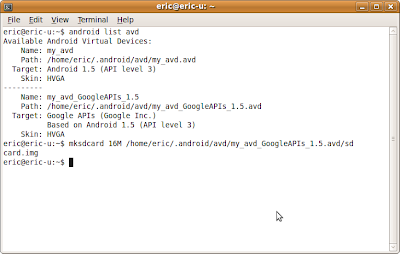
Restart the emulator, click Menu in Android Home screen, then click Settings > SD Card & phone storage. Now, you can see the SD Card here.
With 16M SD Card:
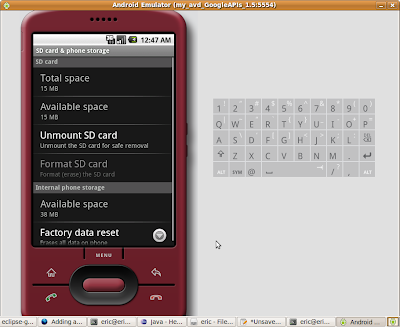
Without SD Card, before adding the SDCard image:
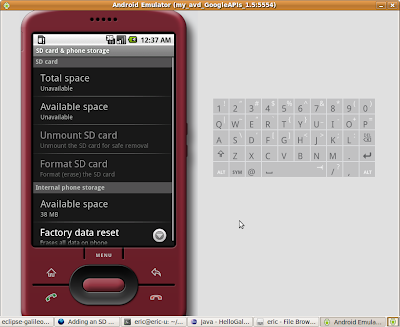
next >> Copying Files to a Disk Image
--------------------------------------------------------
it's another approach, Create SD Card in Android Emulator and copy files into, in Eclipse, Emulator and DDMS.
- Firstly, locate the path of your AVD, type the command in Terminal:
$android list avd
- Create a SDCard image, named "sdcard.img" (it's the default name for the emulator to load).
In my case, I want to add 16M SD Card to the /home/eric/.android/avd/my_avd_GoogleAPIs_1.5.avd.
$mksdcard 16M /home/eric/.android/avd/my_avd_GoogleAPIs_1.5.avd/sdcard.img
where /home/eric/.android/avd/my_avd_GoogleAPIs_1.5.avd/ is the path of my avd.

Restart the emulator, click Menu in Android Home screen, then click Settings > SD Card & phone storage. Now, you can see the SD Card here.
With 16M SD Card:

Without SD Card, before adding the SDCard image:

next >> Copying Files to a Disk Image
--------------------------------------------------------
it's another approach, Create SD Card in Android Emulator and copy files into, in Eclipse, Emulator and DDMS.
Sunday, August 23, 2009
HelloGallery, using Gallery Widget.
Here is a exercise to implement a picture view using Gallery, a view that shows items in a center-locked, horizontally scrolling list.
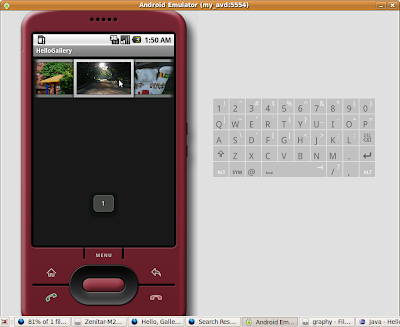
Basically, this exercise follow the Android Tutorial, Hello Gallery. But in my practice, error is complained in building. I have to create a attrs.xml and modify some code to fix it.
Here is how I fix it to make it work.
Create a Android Application, HelloGallery. Copy some images, in .png format, into res/drawable/ directory. Named image_01..05.png in my case.
Android supports bitmap resource files in a few different formats: png (preferred), jpg (acceptable), gif (discouraged). The bitmap file itself is compiled and referenced by the file name without the extension (so res/drawable/my_picture.png would be referenced as R.drawable.my_picture).
Create res/values/attrs.xml to define Theme_android_galleryItemBackground.
Modify main.xml to have a Gallery in the screen.
Finally, modify the HelloGallery.java
 The project files, include some images for demo, can be downloaded here.
The project files, include some images for demo, can be downloaded here.
Next>>HelloGallery, read picture files from SD, using File ArrayList

Basically, this exercise follow the Android Tutorial, Hello Gallery. But in my practice, error is complained in building. I have to create a attrs.xml and modify some code to fix it.
Here is how I fix it to make it work.
Create a Android Application, HelloGallery. Copy some images, in .png format, into res/drawable/ directory. Named image_01..05.png in my case.
Android supports bitmap resource files in a few different formats: png (preferred), jpg (acceptable), gif (discouraged). The bitmap file itself is compiled and referenced by the file name without the extension (so res/drawable/my_picture.png would be referenced as R.drawable.my_picture).
Create res/values/attrs.xml to define Theme_android_galleryItemBackground.
<?xml version="1.0" encoding="utf-8"?>
<resources>
<declare-styleable name="Theme">
<attr name="android:galleryItemBackground" />
</declare-styleable>
</resources>
Modify main.xml to have a Gallery in the screen.
<?xml version="1.0" encoding="utf-8"?>
<Gallery xmlns:android="http://schemas.android.com/apk/res/android"
android:id="@+id/gallery"
android:layout_width="fill_parent"
android:layout_height="wrap_content"
/>
Finally, modify the HelloGallery.java
package com.exercise.HelloGallery;
import android.app.Activity;
import android.content.Context;
import android.content.res.TypedArray;
import android.os.Bundle;
import android.view.View;
import android.view.ViewGroup;
import android.widget.AdapterView;
import android.widget.BaseAdapter;
import android.widget.Gallery;
import android.widget.ImageView;
import android.widget.Toast;
import android.widget.AdapterView.OnItemClickListener;
public class HelloGallery extends Activity {
/** Called when the activity is first created. */
@Override
public void onCreate(Bundle savedInstanceState) {
super.onCreate(savedInstanceState);
setContentView(R.layout.main);
Gallery g = (Gallery) findViewById(R.id.gallery);
g.setAdapter(new ImageAdapter(this));
g.setOnItemClickListener(new OnItemClickListener() {
public void onItemClick(AdapterView<?> parent,
View v, int position, long id) {
Toast.makeText(HelloGallery.this, "" + position,
Toast.LENGTH_SHORT).show();
}
});
}
public class ImageAdapter extends BaseAdapter {
int mGalleryItemBackground;
private Context mContext;
private Integer[] mImageIds = {
R.drawable.image_01,
R.drawable.image_02,
R.drawable.image_03,
R.drawable.image_04,
R.drawable.image_05
};
public ImageAdapter(Context c) {
mContext = c;
TypedArray a = obtainStyledAttributes(R.styleable.Theme);
mGalleryItemBackground = a.getResourceId(
R.styleable.Theme_android_galleryItemBackground,
0);
a.recycle();
}
public int getCount() {
return mImageIds.length;
}
public Object getItem(int position) {
return position;
}
public long getItemId(int position) {
return position;
}
public View getView(int position,
View convertView, ViewGroup parent) {
ImageView i = new ImageView(mContext);
i.setImageResource(mImageIds[position]);
i.setLayoutParams(new Gallery.LayoutParams(150, 100));
i.setScaleType(ImageView.ScaleType.FIT_XY);
i.setBackgroundResource(mGalleryItemBackground);
return i;
}
}
}
Next>>HelloGallery, read picture files from SD, using File ArrayList
live-android 0.3 released
Want to give Google Android a try, but don't feel like buying a T-Mobile G1/G2/G3? LiveAndroid lets you download a LiveCD disc image of the Google Android operating system. Just burn the image to a disc, stick it in a CD-ROM drive, and reboot your computer and you can check out Android without installing it or affecting any files on your PC.
You can also use the disc image in a virtualization application like VirtualBox, VMWare or Microsoft Virtual PC if you want to try the operating system without even rebooting your computer.
v0.3 liveCD released on Aug 21, 2009
live-android 0.3 run on Sun VirtualBox 3.0.4.
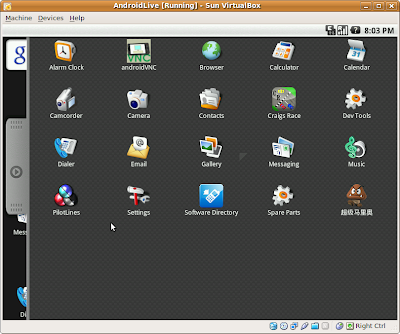
Download
You can also use the disc image in a virtualization application like VirtualBox, VMWare or Microsoft Virtual PC if you want to try the operating system without even rebooting your computer.
v0.3 liveCD released on Aug 21, 2009
live-android 0.3 run on Sun VirtualBox 3.0.4.

Download
- LiveCD
- download
- liveandroidv0.3.iso.001 / liveandroidv0.3.iso.002 at http://code.google.com/p/live-android/downloads/list
- torrent at http://www.mininova.org/get/2870386
- join
- windows, use HJSplit(http://www.freebyte.com/hjsplit/ or http://www.freebytesoftware.com/download/hjsplit.zip) to join it. also use command COPY /B liveandroidv0.3.iso.001 + liveandroidv0.3.iso.002 liveandroidv0.3.iso
- linux, cat liveandroidv0.3.iso.001 liveandroidv0.3.iso.002 > liveandroidv0.3.iso
- size 173M
- check liveandroidv0.3.iso md5sum e0c5c305f78cd958dbaea3716c82296f
Saturday, August 22, 2009
Obtaining a Maps API Key, for debug.
If you are looking for Obtain a Maps API Key for Your Signing Certificate, refer to the article here.
In order to make your Android Maps appliation run, your need a Maps API Key. Here describe a simple steps to obtain a Maps API Key, Details refer to Google document, Obtaining a Maps API Key.
Get your MD5 Fingerprint of the SDK Debug Certificate:
in Eclipse, select Windows > Prefs > Android > Build to check the full path of your MD5 Fingerprint.
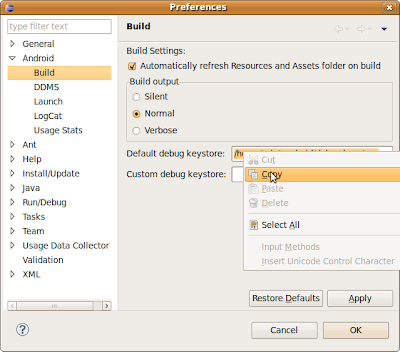
Open a Terminal, type the command:
$ keytool -list -alias androiddebugkey -keystore /home/eric/.android/debug.keystore -storepass android -keypass android
Where /home/eric/.android/debug.keystore is the Default Debug Keystore copied from Eclipse. Your MD5 fingerprint will be shown.
In order to obtain a Maps API Key, you need a Google account, log-in or register one.
Then, you Sign Up for the Android Maps API.
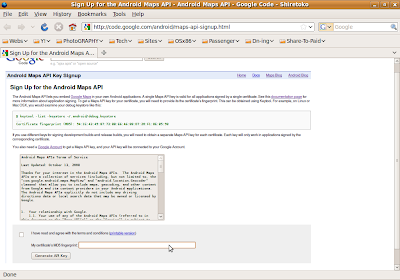
Accept the terms, paste the your MD5 fingerprint in the box, and generate your own API Key.
In order to make your Android Maps appliation run, your need a Maps API Key. Here describe a simple steps to obtain a Maps API Key, Details refer to Google document, Obtaining a Maps API Key.
Get your MD5 Fingerprint of the SDK Debug Certificate:
in Eclipse, select Windows > Prefs > Android > Build to check the full path of your MD5 Fingerprint.

Open a Terminal, type the command:
$ keytool -list -alias androiddebugkey -keystore /home/eric/.android/debug.keystore -storepass android -keypass android
Where /home/eric/.android/debug.keystore is the Default Debug Keystore copied from Eclipse. Your MD5 fingerprint will be shown.
In order to obtain a Maps API Key, you need a Google account, log-in or register one.
Then, you Sign Up for the Android Maps API.

Accept the terms, paste the your MD5 fingerprint in the box, and generate your own API Key.
A minimal Map application using MapActivity, with Android 1.5 SDK r3.
OS: Ubuntu 9.04
Java: Sun JDK 6
Eclipse version: 3.5 Galileo
Android SDK: Android 1.5 SDK r3
It's a very minimal Android Application to display MapView.
Actually, this exercise follow the tutorial, Hello, MapView, with more pictures to describe.
Create a Android Application HelloMapView.
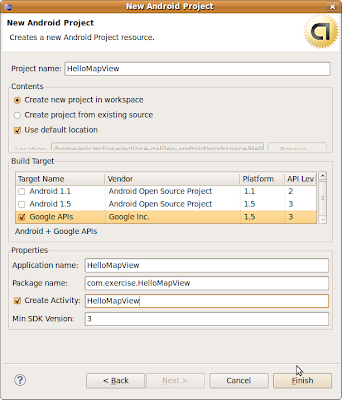
Modify AndroidManifest.xml:
Add <uses-library android:name="com.google.android.maps" /> as a child of the <application> element.
Add <uses-permission android:name="android.permission.INTERNET" /> a child of the <manifest> element.
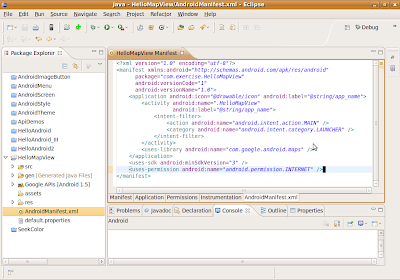
Modify main.xml to add a MapView.
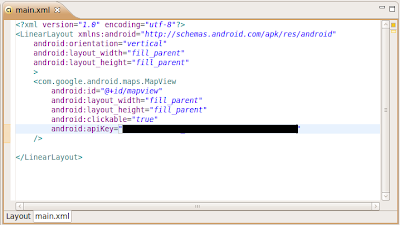
You have to Obtaining a Maps API Key, and insert into the field "apikey"
Modify HelloMapView to extends HelloMapView from MapActivity, and also override isRouteDisplayed().
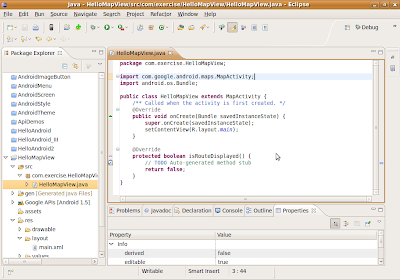
You can actually run this now, but all it does is allow you to pan around the map.
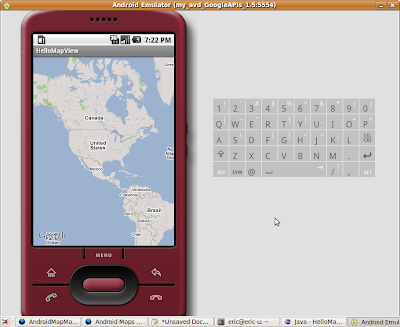
 The project files can be downloaded here. Please note that you cannot run the application directly, you have to insert your own apikey, in order to make it work.
The project files can be downloaded here. Please note that you cannot run the application directly, you have to insert your own apikey, in order to make it work.
Java: Sun JDK 6
Eclipse version: 3.5 Galileo
Android SDK: Android 1.5 SDK r3
It's a very minimal Android Application to display MapView.
Actually, this exercise follow the tutorial, Hello, MapView, with more pictures to describe.
Create a Android Application HelloMapView.

Modify AndroidManifest.xml:
Add <uses-library android:name="com.google.android.maps" /> as a child of the <application> element.
Add <uses-permission android:name="android.permission.INTERNET" /> a child of the <manifest> element.

Modify main.xml to add a MapView.

You have to Obtaining a Maps API Key, and insert into the field "apikey"
Modify HelloMapView to extends HelloMapView from MapActivity, and also override isRouteDisplayed().

You can actually run this now, but all it does is allow you to pan around the map.

Friday, August 21, 2009
Exercise: Change background color, by SeekBar
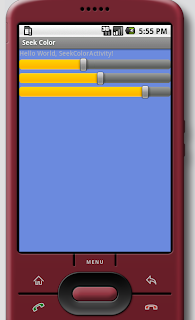
In this exercise, the background color is changed, controlled by SeekBar.
A SeekBar is an extension of ProgressBar that adds a draggable thumb. The user can touch the thumb and drag left or right to set the current progress level or use the arrow keys.
When SeekBarChange, the onProgressChanged() of OnSeekBarChangeListener will be called, and the background of the screen(LinearLayout) will be updated according to the value (SeekBar.getProgress()).
Create a Android Application, SeekColor, with three SeekBar for Red, Green and Blue setting.
main.xml
<?xml version="1.0" encoding="utf-8"?>
<LinearLayout xmlns:android="http://schemas.android.com/apk/res/android"
android:orientation="vertical"
android:layout_width="fill_parent"
android:layout_height="fill_parent"
android:id="@+id/myScreen"
>
<TextView
android:layout_width="fill_parent"
android:layout_height="wrap_content"
android:text="@string/hello"
/>
<SeekBar
android:id="@+id/mySeekingBar_R"
android:layout_width="fill_parent"
android:layout_height="wrap_content"
android:max="255"
android:progress="0"/>
<SeekBar
android:id="@+id/mySeekingBar_G"
android:layout_width="fill_parent"
android:layout_height="wrap_content"
android:max="255"
android:progress="0"/>
<SeekBar
android:id="@+id/mySeekingBar_B"
android:layout_width="fill_parent"
android:layout_height="wrap_content"
android:max="255"
android:progress="0"/>
</LinearLayout>
SeekColorActivity.java
package com.exercise.seekcolor;
import android.app.Activity;
import android.os.Bundle;
import android.widget.LinearLayout;
import android.widget.SeekBar;
public class SeekColorActivity extends Activity {
private int seekR, seekG, seekB;
SeekBar redSeekBar, greenSeekBar, blueSeekBar;
LinearLayout mScreen;
/** Called when the activity is first created. */
@Override
public void onCreate(Bundle savedInstanceState) {
super.onCreate(savedInstanceState);
setContentView(R.layout.main);
mScreen = (LinearLayout) findViewById(R.id.myScreen);
redSeekBar = (SeekBar) findViewById(R.id.mySeekingBar_R);
greenSeekBar = (SeekBar) findViewById(R.id.mySeekingBar_G);
blueSeekBar = (SeekBar) findViewById(R.id.mySeekingBar_B);
updateBackground();
redSeekBar.setOnSeekBarChangeListener(seekBarChangeListener);
greenSeekBar.setOnSeekBarChangeListener(seekBarChangeListener);
blueSeekBar.setOnSeekBarChangeListener(seekBarChangeListener);
}
private SeekBar.OnSeekBarChangeListener seekBarChangeListener
= new SeekBar.OnSeekBarChangeListener()
{
@Override
public void onProgressChanged(SeekBar seekBar, int progress,
boolean fromUser) {
// TODO Auto-generated method stub
updateBackground();
}
@Override
public void onStartTrackingTouch(SeekBar seekBar) {
// TODO Auto-generated method stub
}
@Override
public void onStopTrackingTouch(SeekBar seekBar) {
// TODO Auto-generated method stub
}
};
private void updateBackground()
{
seekR = redSeekBar.getProgress();
seekG = greenSeekBar.getProgress();
seekB = blueSeekBar.getProgress();
mScreen.setBackgroundColor(
0xff000000
+ seekR * 0x10000
+ seekG * 0x100
+ seekB
);
}
}
Sunday, August 16, 2009
Exercise: Load background to ImageButton, in programmatical approach
In addition to "Load background to ImageButton, using XML", Android support programmatic approach also, using setImageResource().
In this exercise, I implement ImageButton.setOnFocusChangeListener() and ImageButton.setOnClickListener() to handle the background image of the ImageButton. The outcome is same as the "Load background to ImageButton, using XML".



Download and save the three image above to res > drawable folder.
Add a ImageButton in main.xml
Modify the source code to implement setOnFocusChangeListener() and setOnClickListener()
In this exercise, I implement ImageButton.setOnFocusChangeListener() and ImageButton.setOnClickListener() to handle the background image of the ImageButton. The outcome is same as the "Load background to ImageButton, using XML".



Download and save the three image above to res > drawable folder.
Add a ImageButton in main.xml
<?xml version="1.0" encoding="utf-8"?>
<LinearLayout xmlns:android="http://schemas.android.com/apk/res/android"
android:orientation="vertical"
android:layout_width="fill_parent"
android:layout_height="fill_parent"
>
<TextView
android:layout_width="fill_parent"
android:layout_height="wrap_content"
android:text="@string/hello"
/>
<ImageButton
android:id="@+id/myImageButton"
android:layout_width="wrap_content"
android:layout_height="wrap_content"
android:background="@drawable/android"
/>
</LinearLayout>
Modify the source code to implement setOnFocusChangeListener() and setOnClickListener()
package com.exercise.AndroidImageButton;
import android.app.Activity;
import android.os.Bundle;
import android.view.View;
import android.view.View.OnClickListener;
import android.view.View.OnFocusChangeListener;
import android.widget.ImageButton;
public class AndroidImageButtonActivity extends Activity {
private ImageButton mImageButton;
/** Called when the activity is first created. */
@Override
public void onCreate(Bundle savedInstanceState) {
super.onCreate(savedInstanceState);
setContentView(R.layout.main);
mImageButton = (ImageButton) findViewById(R.id.myImageButton);
mImageButton.setOnFocusChangeListener(
new OnFocusChangeListener()
{
@Override
public void onFocusChange(View v, boolean hasFocus) {
// TODO Auto-generated method stub
if (hasFocus==true)
{
mImageButton.setImageResource(R.drawable.androidonfocus);
}
else
{
mImageButton.setImageResource(R.drawable.android);
}
}
});
mImageButton.setOnClickListener(
new OnClickListener() {
@Override
public void onClick(View v) {
// TODO Auto-generated method stub
mImageButton.setImageResource(R.drawable.androidonclick);
}
});
}
}
Exercise: Load background to ImageButton, using XML
Default of ImageButton:
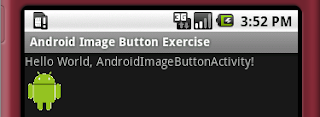
Button On Focus:
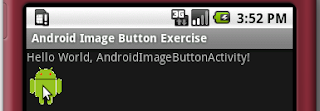
Button On Click:
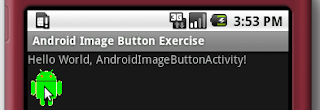
The backgound of ImageButton can be defined in main.xml, without any works on programming.



Download and save the three image above to res > drawable folder.
Create a loadimagebutton.xml in res > drawable folder.
Modify main.xml to involve loadimagebutton
(To achieve the same out-come using programmatical approach, refer to the next article, Exercise: Load background to ImageButton, in programmatical approach.)

Button On Focus:

Button On Click:

The backgound of ImageButton can be defined in main.xml, without any works on programming.



Download and save the three image above to res > drawable folder.
Create a loadimagebutton.xml in res > drawable folder.
<?xml version="1.0" encoding="utf-8"?>
<selector
xmlns:android="http://schemas.android.com/apk/res/android">
<item
android:state_focused="true"
android:state_pressed="false"
android:drawable="@drawable/androidonfocus" />
<item
android:state_focused="true"
android:state_pressed="true"
android:drawable="@drawable/androidonclick" />
<item
android:state_focused="false"
android:state_pressed="true"
android:drawable="@drawable/androidonclick" />
<item
android:drawable="@drawable/android" />
</selector>
Modify main.xml to involve loadimagebutton
<?xml version="1.0" encoding="utf-8"?>
<LinearLayout xmlns:android="http://schemas.android.com/apk/res/android"
android:orientation="vertical"
android:layout_width="fill_parent"
android:layout_height="fill_parent"
>
<TextView
android:layout_width="fill_parent"
android:layout_height="wrap_content"
android:text="@string/hello"
/>
<ImageButton
android:background="@drawable/loadimagebutton"
android:layout_width="wrap_content"
android:layout_height="wrap_content"
/>
</LinearLayout>
(To achieve the same out-come using programmatical approach, refer to the next article, Exercise: Load background to ImageButton, in programmatical approach.)
Friday, August 14, 2009
Exercise: style
A style is a set of one or more formatting attributes that you can apply as a unit to single elements in your layout XML file(s). For example, you could define a style that specifies a certain text size and color, then apply it to instances of a certain type of View element.
details>>
Create a dummy Android Application, AndroidStyle. Create style.xml in the folder res > values
Modify main.xml to apply the styles.
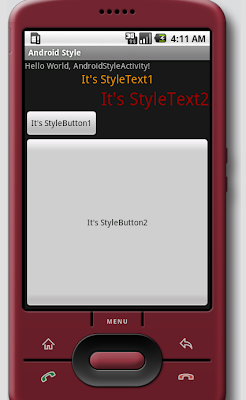
details>>
Create a dummy Android Application, AndroidStyle. Create style.xml in the folder res > values
<?xml version="1.0" encoding="utf-8"?>
<resources>
<style name="StyleText1">
<item name="android:textSize">20sp</item>
<item name="android:textColor">#EC9200</item>
<item name="android:gravity">center_horizontal</item>
</style>
<style name="StyleText2">
<item name="android:textSize">30sp</item>
<item name="android:textColor">#990000</item>
<item name="android:gravity">right</item>
</style>
<style name="StyleButton1">
<item name="android:layout_width">wrap_content</item>
<item name="android:layout_height">wrap_content</item>
</style>
<style name="StyleButton2">
<item name="android:layout_width">fill_parent</item>
<item name="android:layout_height">fill_parent</item>
</style>
</resources>
Modify main.xml to apply the styles.
<?xml version="1.0" encoding="utf-8"?>
<LinearLayout xmlns:android="http://schemas.android.com/apk/res/android"
android:orientation="vertical"
android:layout_width="fill_parent"
android:layout_height="fill_parent"
>
<TextView
android:layout_width="fill_parent"
android:layout_height="wrap_content"
android:text="@string/hello"
/>
<TextView
style="@style/StyleText1"
android:layout_width="fill_parent"
android:layout_height="wrap_content"
android:text="It's StyleText1"
/>
<TextView
style="@style/StyleText2"
android:layout_width="fill_parent"
android:layout_height="wrap_content"
android:text="It's StyleText2"
/>
<Button
style="@style/StyleButton1"
android:text="It's StyleButton1"
/>
<Button
style="@style/StyleButton2"
android:text="It's StyleButton2"
/>
</LinearLayout>

Thursday, August 13, 2009
Exercise: Get screen resolution using android.util.DisplayMetrics
android.util.DisplayMetrics is a structure describing general information about a display, such as its size, density, and font scaling.
To use android.util.DisplayMetrics to get resolution:
Create a dummy Android Application, add a TextView in main.xml to display the result.
<TextView
android:id="@+id/strScreenSize"
android:layout_width="fill_parent"
android:layout_height="wrap_content"
android:text=""
/>
Modify the .java file to read DisplayMetrics
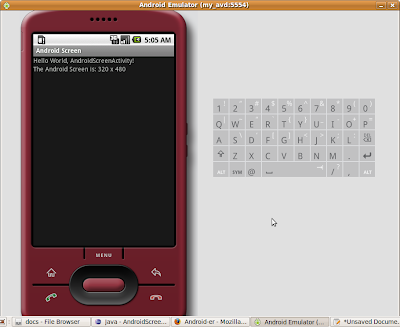
Related Post:
- Get screen size in DPI
To use android.util.DisplayMetrics to get resolution:
Create a dummy Android Application, add a TextView in main.xml to display the result.
<TextView
android:id="@+id/strScreenSize"
android:layout_width="fill_parent"
android:layout_height="wrap_content"
android:text=""
/>
Modify the .java file to read DisplayMetrics
package com.exercise.AndroidScreen;
import android.app.Activity;
import android.os.Bundle;
import android.util.DisplayMetrics;
import android.widget.TextView;
public class AndroidScreenActivity extends Activity {
/** Called when the activity is first created. */
@Override
public void onCreate(Bundle savedInstanceState) {
super.onCreate(savedInstanceState);
setContentView(R.layout.main);
DisplayMetrics dm = new DisplayMetrics();
getWindowManager().getDefaultDisplay().getMetrics(dm);
String str_ScreenSize = "The Android Screen is: "
+ dm.widthPixels
+ " x "
+ dm.heightPixels;
TextView mScreenSize = (TextView) findViewById(R.id.strScreenSize);
mScreenSize.setText(str_ScreenSize);
}
}

Related Post:
- Get screen size in DPI
Exercise: Apply Theme in AndroidManifest.xml
Android provide some predefine themes in the base package, you can change the theme by adding a code in the file AndroidManifest.xml.
Inside Application tag to take effect on whole Application.
Or,
Inside Activity tag to take effect on individual Activity.
@android:style/Theme.Black
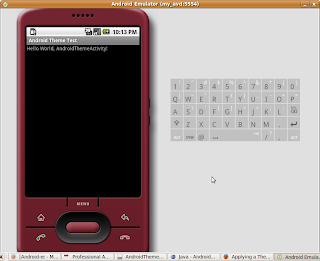
@android:style/Theme.Light
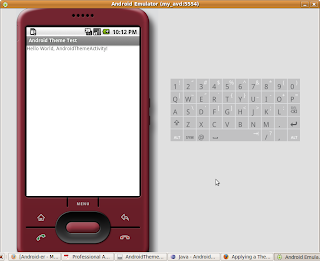
@android:style/Theme.Translucent
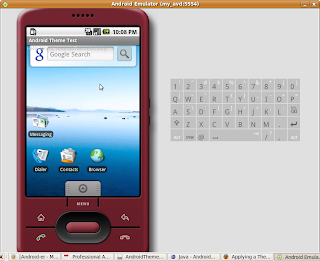
Inside Application tag to take effect on whole Application.
<?xml version="1.0" encoding="utf-8"?>
<manifest xmlns:android="http://schemas.android.com/apk/res/android"
package="com.exercise.AndroidTheme"
android:versionCode="1"
android:versionName="1.0">
<application android:icon="@drawable/icon" android:label="@string/app_name"
android:theme="@android:style/Theme.Black"
>
<activity android:name=".AndroidThemeActivity"
android:label="@string/app_name">
<intent-filter>
<action android:name="android.intent.action.MAIN" />
<category android:name="android.intent.category.LAUNCHER" />
</intent-filter>
</activity>
</application>
<uses-sdk android:minSdkVersion="2" />
</manifest>
Or,
Inside Activity tag to take effect on individual Activity.
<?xml version="1.0" encoding="utf-8"?>
<manifest xmlns:android="http://schemas.android.com/apk/res/android"
package="com.exercise.AndroidTheme"
android:versionCode="1"
android:versionName="1.0">
<application android:icon="@drawable/icon" android:label="@string/app_name"
>
<activity android:name=".AndroidThemeActivity"
android:label="@string/app_name"
android:theme="@android:style/Theme.Light"
>
<intent-filter>
<action android:name="android.intent.action.MAIN" />
<category android:name="android.intent.category.LAUNCHER" />
</intent-filter>
</activity>
</application>
<uses-sdk android:minSdkVersion="2" />
</manifest>
@android:style/Theme.Black

@android:style/Theme.Light

@android:style/Theme.Translucent

Tuesday, August 11, 2009
An early alpha release of e4, the next generation of the Eclipse platform, is now available.
An early alpha release of e4, the next generation of the Eclipse platform, is now available.
The mission of the e4 project is to build a next generation platform for pervasive, component-based applications and tools. See the about page as well as the original project proposal for more details.
I tried to install, with ADT and Android SDK. And also tried Hello Android. It seem to be compatible. The install procedure is same as Install Android SDK on Eclipse 3.5 Galileo.

The mission of the e4 project is to build a next generation platform for pervasive, component-based applications and tools. See the about page as well as the original project proposal for more details.
I tried to install, with ADT and Android SDK. And also tried Hello Android. It seem to be compatible. The install procedure is same as Install Android SDK on Eclipse 3.5 Galileo.

Simple steps to change the drawable icon with Transparency background using GIMP
 In the Exercise: Add a icon on Dialog, the background of android icon is in white. It can be removed to be transparency using GIMP.
In the Exercise: Add a icon on Dialog, the background of android icon is in white. It can be removed to be transparency using GIMP.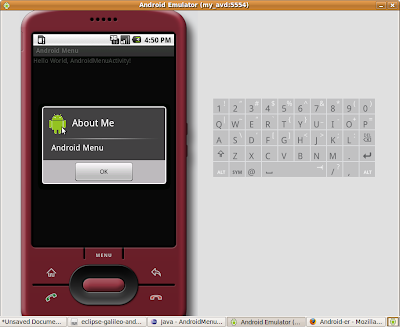
Open the android.png in GIMP.
Select Fuzzy Select Tool.
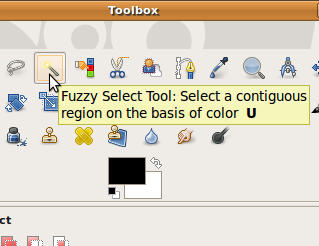
Click on the background of the icon.
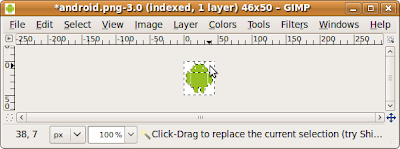
Click Select > Invert to select the foreground image.
Click Edit > Copy to copy the select image to clipboard.
Close the original file.
Click File > New to create a new image
Expend the Advanced Options in the Create a New Image dialog.
Select Transparency in the Fill with option, and click OK.
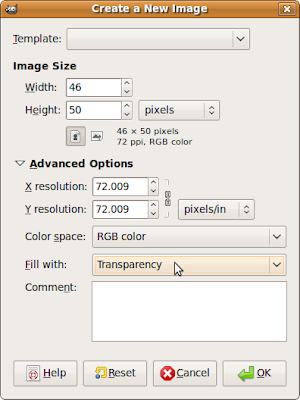
Click Edit > Paste to paste the copied image as the foreground.
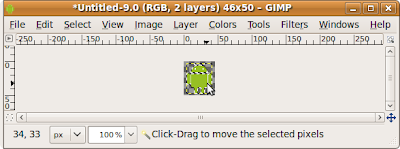
Run the Android Application again, the background have been changed to transparency now.
Monday, August 10, 2009
Exercise: Add a icon on Dialog
Extends from the previous exercise, Exercise: Menu and Dialog. A icon will be added on the About me Dialog, as shown:
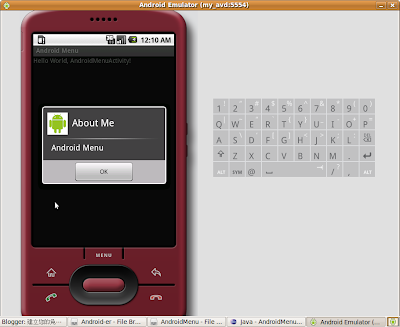
Save the icon, , in the folder res/drawable.
, in the folder res/drawable.
Add one line in the openOptionsDialog() class:
Next: Simple steps to change the drawable icon with Transparency background using GIMP

Save the icon,
 , in the folder res/drawable.
, in the folder res/drawable.Add one line in the openOptionsDialog() class:
private void openOptionsDialog()
{
new AlertDialog.Builder(this)
.setTitle(R.string.app_about)
.setIcon(R.drawable.android)
.setMessage(R.string.app_about_message)
.setPositiveButton(R.string.str_ok,
new DialogInterface.OnClickListener()
{
public void onClick(DialogInterface dialoginterface, int i)
{
}
})
.show();
}
Next: Simple steps to change the drawable icon with Transparency background using GIMP
Saturday, August 8, 2009
Exercise: Menu and Dialog
In this article, option menu and dialog will be added to Android Application.
 The project files can be downloaded here.
The project files can be downloaded here.
Create a new Android Application with the following setting:
Project name: AndroidMenu
Application name: Android Menu
Package name: com.example.androidMenu
Create Activity: AndroidMenuActivity
Min SDK Version: 2
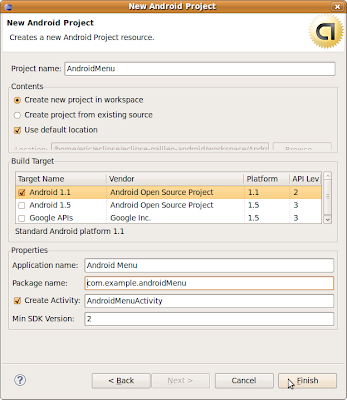
Use the technique described in the article, Tips and Tricks in using Eclipse: Override a method from a base class, to insert methods onCreateOptionsMenu and onOptionsItemSelected.
Right click on the Source Code Editor and invoke Source > Override/Implement Methods.
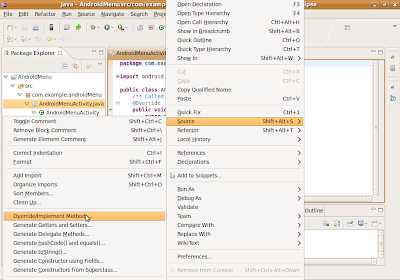
Find and select onCreateOptionsMenu and onOptionsItemSelected, select the insertion position, and click OK.
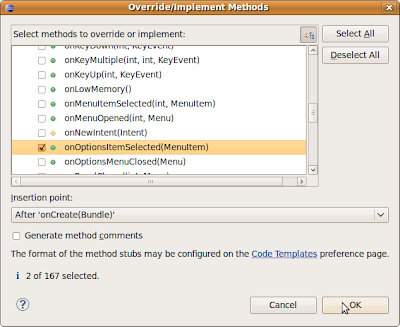
The selected methods will be inserted with dummy code, the need files, android.view.Menu and android.view.MenuItem, will be imported also.
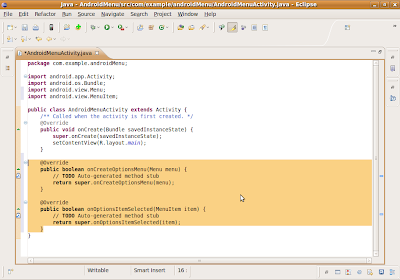
We have to add string constane in the string.xml file.
Modify R.string in res>values>string.xml, add the items:
<string name="app_about">About Me</string>
<string name="str_exit">Exit</string>
<string name="app_about_message">Android Menu</string>
<string name="str_ok">OK</string>
<string name="app_exit">Exit</string>
<string name="app_exit_message">Exit?</string>
<string name="str_no">No</string>
Modify onCreateOptionsMenu(Menu menu), onOptionsItemSelected(MenuItem item) and implement openOptionsDialog() and exitOptionsDialog().
In order to use AlertDialog, DialogInterface, two more classes have to be imported:
import android.app.AlertDialog;
import android.content.DialogInterface;
Run the application, click the MENU button, two Menu Option, About Me and Exit, will be displayed.
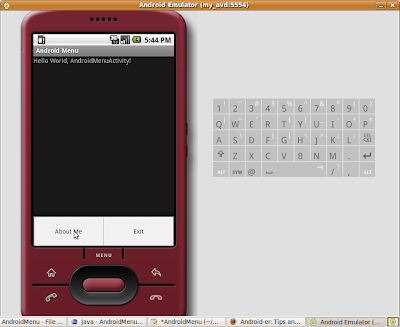 Click About Me will show the About Me dialog
Click About Me will show the About Me dialog
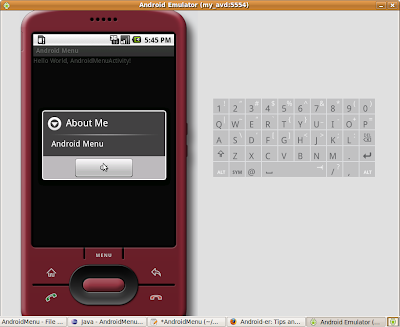 Click Exit will show a Exit dialog asking to confirm exit.
Click Exit will show a Exit dialog asking to confirm exit.
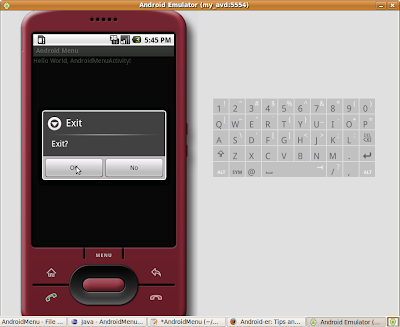
 The project files can be downloaded here.
The project files can be downloaded here.
Create a new Android Application with the following setting:
Project name: AndroidMenu
Application name: Android Menu
Package name: com.example.androidMenu
Create Activity: AndroidMenuActivity
Min SDK Version: 2

Use the technique described in the article, Tips and Tricks in using Eclipse: Override a method from a base class, to insert methods onCreateOptionsMenu and onOptionsItemSelected.
Right click on the Source Code Editor and invoke Source > Override/Implement Methods.

Find and select onCreateOptionsMenu and onOptionsItemSelected, select the insertion position, and click OK.

The selected methods will be inserted with dummy code, the need files, android.view.Menu and android.view.MenuItem, will be imported also.

We have to add string constane in the string.xml file.
Modify R.string in res>values>string.xml, add the items:
<string name="app_about">About Me</string>
<string name="str_exit">Exit</string>
<string name="app_about_message">Android Menu</string>
<string name="str_ok">OK</string>
<string name="app_exit">Exit</string>
<string name="app_exit_message">Exit?</string>
<string name="str_no">No</string>
Modify onCreateOptionsMenu(Menu menu), onOptionsItemSelected(MenuItem item) and implement openOptionsDialog() and exitOptionsDialog().
@Override
public boolean onCreateOptionsMenu(Menu menu) {
// TODO Auto-generated method stub
menu.add(0, 0, 0, R.string.app_about);
menu.add(0, 1, 1, R.string.str_exit);
return super.onCreateOptionsMenu(menu);
}
@Override
public boolean onOptionsItemSelected(MenuItem item) {
// TODO Auto-generated method stub
super.onOptionsItemSelected(item);
switch(item.getItemId())
{
case 0:
openOptionsDialog();
break;
case 1:
exitOptionsDialog();
break;
}
return true;
}
private void openOptionsDialog()
{
new AlertDialog.Builder(this)
.setTitle(R.string.app_about)
.setMessage(R.string.app_about_message)
.setPositiveButton(R.string.str_ok,
new DialogInterface.OnClickListener()
{
public void onClick(DialogInterface dialoginterface, int i)
{
}
})
.show();
}
private void exitOptionsDialog()
{
new AlertDialog.Builder(this)
.setTitle(R.string.app_exit)
.setMessage(R.string.app_exit_message)
.setNegativeButton(R.string.str_no,
new DialogInterface.OnClickListener()
{
public void onClick(DialogInterface dialoginterface, int i)
{}
})
.setPositiveButton(R.string.str_ok,
new DialogInterface.OnClickListener()
{
public void onClick(DialogInterface dialoginterface, int i)
{
finish();
}
})
.show();
}
In order to use AlertDialog, DialogInterface, two more classes have to be imported:
import android.app.AlertDialog;
import android.content.DialogInterface;
Run the application, click the MENU button, two Menu Option, About Me and Exit, will be displayed.
 Click About Me will show the About Me dialog
Click About Me will show the About Me dialog Click Exit will show a Exit dialog asking to confirm exit.
Click Exit will show a Exit dialog asking to confirm exit.
Wednesday, August 5, 2009
Exercise: Intent & Bundle
In the previous exercise, I implemented one activity with two layout. In this exercise, I implement the same application, with same function and presentation, using two activity, HelloAndroid.java and HelloAndroid_2.java. The activity is switched using Intent, the data is passed using Bundle.
We can keep both layout, main.xml and main2.xml, no change.
We have to re-write HelloAndroid.java to two separated files, HelloAndroid.java and HelloAndroid_2.java.
 HelloAndroid.java
HelloAndroid.java
 HelloAndroid_2.java
HelloAndroid_2.java
Because we have two activity, so we have to modify the file AndroidManifest.xml, to include the additional activity.
 AndroidManifest.xml
AndroidManifest.xml
 The project files can be downloaded here.
The project files can be downloaded here.
We can keep both layout, main.xml and main2.xml, no change.
We have to re-write HelloAndroid.java to two separated files, HelloAndroid.java and HelloAndroid_2.java.
package com.example.helloandroid3;
import android.app.Activity;
import android.content.Intent;
import android.os.Bundle;
import android.widget.Button;
import android.widget.EditText;
import android.view.View;
public class HelloAndroid extends Activity {
private
Button okButton;
Button cancel1Button;
EditText textName;
EditText textPhonenumberIs;
EditText textEmailIs;
EditText textWebsiteIs;
EditText textAddressIs;
/** Called when the activity is first created. */
@Override
public void onCreate(Bundle savedInstanceState) {
super.onCreate(savedInstanceState);
startLayout1();
}
private Button.OnClickListener okOnClickListener = new Button.OnClickListener(){
@Override
public void onClick(View v) {
textName = (EditText) findViewById(R.id.whoareyou);
CharSequence textName_value = textName.getText();
textPhonenumberIs = (EditText) findViewById(R.id.phonenumberIs);
CharSequence textPhonenumberIs_value = textPhonenumberIs.getText();
textEmailIs = (EditText) findViewById(R.id.emailIs);
CharSequence textEmailIs_value = textEmailIs.getText();
textWebsiteIs = (EditText) findViewById(R.id.websiteIs);
CharSequence textWebsiteIs_value = textWebsiteIs.getText();
textAddressIs = (EditText) findViewById(R.id.addressIs);
CharSequence textAddressIs_value = textAddressIs.getText();
Intent intent = new Intent();
intent.setClass(HelloAndroid.this, HelloAndroid_2.class);
Bundle bundle = new Bundle();
bundle.putCharSequence("bName", textName_value);
bundle.putCharSequence("bPhonenumber", textPhonenumberIs_value);
bundle.putCharSequence("bEmail", textEmailIs_value);
bundle.putCharSequence("bWebsite", textWebsiteIs_value);
bundle.putCharSequence("bAddress", textAddressIs_value);
intent.putExtras(bundle);
startActivity(intent);
finish();
}
};
private Button.OnClickListener cancelOnClickListener = new Button.OnClickListener(){
@Override
public void onClick(View v) {
finish();
}
};
private void startLayout1(){
setContentView(R.layout.main);
okButton = (Button) findViewById(R.id.ok);
okButton.setOnClickListener(okOnClickListener);
cancel1Button = (Button) findViewById(R.id.cancel_1);
cancel1Button.setOnClickListener(cancelOnClickListener);
};
}
package com.example.helloandroid3;
import android.app.Activity;
import android.content.Intent;
import android.os.Bundle;
import android.widget.Button;
import android.widget.TextView;
import android.view.View;
public class HelloAndroid_2 extends Activity {
private
Button backButton;
Button cancel2Button;
TextView nameField;
TextView phonenumberField;
TextView emailField;
TextView websiteField;
TextView addressField;
/** Called when the activity is first created. */
@Override
public void onCreate(Bundle savedInstanceState) {
super.onCreate(savedInstanceState);
startLayout2();
Bundle bundle = this.getIntent().getExtras();
CharSequence textName_value = bundle.getCharSequence("bName");
nameField = (TextView) findViewById(R.id.name);
nameField.setText("Hello "+textName_value);
CharSequence textPhonenumberIs_value = bundle.getCharSequence("bPhonenumber");
phonenumberField = (TextView) findViewById(R.id.phonenumber);
phonenumberField.setText("Phone Number: "+textPhonenumberIs_value);
CharSequence textEmailIs_value = bundle.getCharSequence("bEmail");
emailField = (TextView) findViewById(R.id.email);
emailField.setText("Email: "+textEmailIs_value);
CharSequence textWebsiteIs_value = bundle.getCharSequence("bWebsite");
websiteField = (TextView) findViewById(R.id.website);
websiteField.setText("Website: "+textWebsiteIs_value);
CharSequence textAddressIs_value = bundle.getCharSequence("bAddress");
addressField = (TextView) findViewById(R.id.address);
addressField.setText("Address: "+textAddressIs_value);
};
private Button.OnClickListener backOnClickListener = new Button.OnClickListener(){
@Override
public void onClick(View v) {
Intent intent = new Intent();
intent.setClass(HelloAndroid_2.this, HelloAndroid.class);
startActivity(intent);
finish();
}
};
private Button.OnClickListener cancelOnClickListener = new Button.OnClickListener(){
@Override
public void onClick(View v) {
finish();
}
};
private void startLayout2(){
setContentView(R.layout.main2);
backButton = (Button) findViewById(R.id.back);
backButton.setOnClickListener(backOnClickListener);
cancel2Button = (Button) findViewById(R.id.cancel_2);
cancel2Button.setOnClickListener(cancelOnClickListener);
};
}
Because we have two activity, so we have to modify the file AndroidManifest.xml, to include the additional activity.
<?xml version="1.0" encoding="utf-8"?>
<manifest xmlns:android="http://schemas.android.com/apk/res/android"
package="com.example.helloandroid3"
android:versionCode="1"
android:versionName="1.0">
<application android:icon="@drawable/icon" android:label="@string/app_name">
<activity android:name=".HelloAndroid"
android:label="@string/app_name">
<intent-filter>
<action android:name="android.intent.action.MAIN" />
<category android:name="android.intent.category.LAUNCHER" />
</intent-filter>
</activity>
<activity android:name=".HelloAndroid_2"></activity>
</application>
<uses-sdk android:minSdkVersion="2" />
</manifest>
Subscribe to:
Comments (Atom)